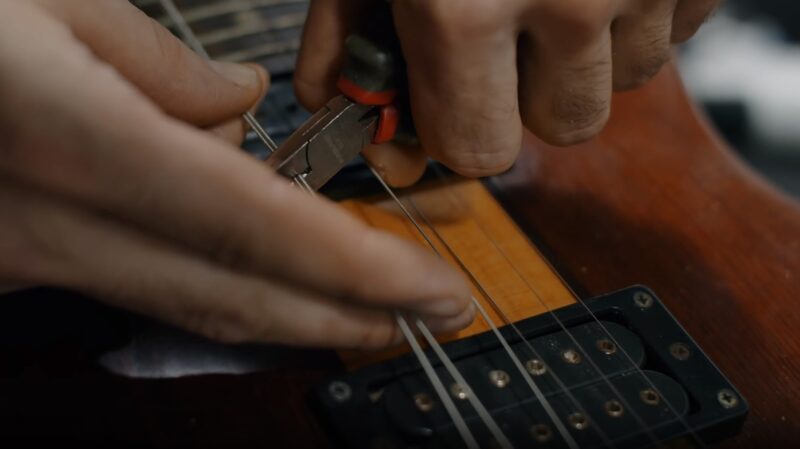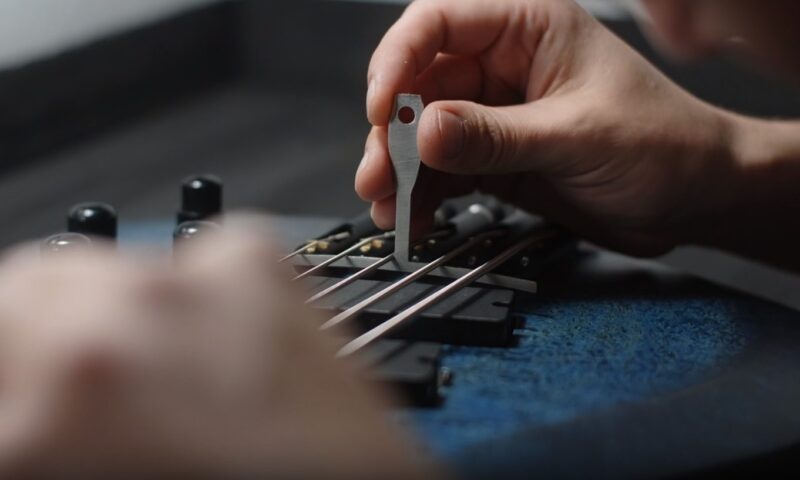Restringing an acoustic guitar is crucial for maintaining its sound quality and playability. It involves more than just replacing broken strings; it’s about preserving the instrument’s tonal integrity.
Fresh strings can significantly enhance your guitar’s sound, making it brighter and clearer. Strings, being the essence of your guitar, lose their vibrancy over time due to dirt, oils, and air exposure, affecting tonal quality and tuning stability.
Regular restringing ensures optimal sound, vital for practice, recording, or live performance. Key indicators for restringing include a loss of tone, tuning difficulties, visible wear, or a rough feel. Even infrequently played guitars need string changes every 3 to 6 months.
Staying attentive to these signs ensures your guitar always performs at its best, enhancing your playing experience.
Before You Start

Ready to breathe new life into your acoustic guitar? Restringing can restore its vibrant sound and enhance its playability.
This guide will walk you through the process, from gathering materials to achieving perfect pitch.
Materials Needed
- Guitar Strings: Invest in a new set of strings designed for your specific guitar type and playing style.
- String Winder: This handy tool expedites the string winding process, making it faster and easier.
- Wire Cutters: Trim away excess string after winding.
- Pliers: These can help remove stubborn bridge pins.
- Guitar Tuner: An essential tool for tuning your new strings to the correct pitch.
Preparation
- Gather Materials: Collect all the items listed above and keep them within easy reach.
- Workspace: Choose a clean, well-lit, and flat surface to work on. This provides a comfortable and organized environment.
- Lighting: Ensure adequate lighting to see the fine details of the restringing process.
By preparing these materials and establishing a suitable workspace, you’re ready to embark on a successful restringing journey!
Restringing the Guitar

Start by loosening the tension of each string using the tuning pegs. Turn the pegs slowly until the strings are slack and easy to handle.
Once loosened, use wire cutters to carefully snip the strings near the middle. This will make it easier to remove them from the bridge pins at the bottom of the guitar. Gently pull out the remaining string segments from the bridge pins and the tuning pegs.
Cleaning the Guitar
With the old strings removed, it’s a good opportunity to clean your guitar. Use a soft cloth to wipe down the fretboard, removing any dirt or residue that has built up.
Clean the body and headstock as well, paying attention to any hard-to-reach areas. This is also the perfect time to inspect your guitar for any maintenance issues that might need addressing, such as loose hardware or worn frets.
Restringing the Guitar
Now you’re ready to put on the new strings. Start by threading the end of a new string through the corresponding bridge pinhole, making sure it’s secure.
Then, pull the string up to the headstock and thread it through the hole in the tuning peg. Begin winding the string around the peg, making sure it’s tight and evenly coiled.
Once all the strings are in place, use your guitar tuner to get each string to the correct pitch. It’s normal for new strings to stretch a bit, so you may need to retune a few times until they stabilize.
Tuning and Stretching

Now that your new strings are proudly in place, it’s time to bring them to life with stretching. Follow these steps for optimal sound and playability.
Stretching the Strings
To ensure your guitar strings adapt to their new environment, start by gently pulling each string away from the fretboard. Apply moderate and steady pressure, hold the stretch for a few moments, then release and proceed to retune the string.
This process should be repeated for all six strings. The act of stretching is crucial as it allows the strings to settle at the proper tension, maintaining their tuning stability over time.
Final Tuning and Adjustments
After stretching, grab your guitar tuner and fine-tune each string to achieve the perfect pitch. Once the strings are precisely tuned, use wire cutters to trim any excess length from the tuning pegs.
This step is important to prevent any interference with the sound or unwanted buzzing noises. Now, play your guitar and listen attentively for any intonation issues or buzzing sounds. If you notice anything amiss, make the necessary adjustments to the tuning or string height.
Congratulations on successfully restringing your guitar! It’s now ready to deliver a fresh and vibrant sound. Remember, new strings may initially be more susceptible to detuning, so handle them with care.
With regular playing and proper maintenance, your guitar will remain in tune and sound its best.
Guitar Restringing Tips

When restringing your guitar, it’s important to follow some best practices to ensure the longevity and sound quality of your strings. Here are a few tips to keep in mind.
Avoid Overwinding
Overwinding the strings can put excessive tension on them, leading to premature breakage. Wind the strings just enough so they are snug around the tuning pegs, with no more than two to three wraps.
Stretch Your Strings
After installing new strings, gently stretch them by pulling them upwards away from the fretboard and then returning. This helps the strings reach their optimal tension and can prevent detuning during play.
Seek Professional Help
If you’re unsure about restringing your guitar or if you’re not getting the desired results, don’t hesitate to take your instrument to a professional luthier or guitar technician. They have the expertise to restring your guitar correctly and can also provide additional maintenance if needed.
Remember, proper restringing can enhance your guitar’s performance and make your playing experience more enjoyable.
FAQ
How often should I restring my acoustic guitar?
It’s recommended to restring your guitar every 3 to 6 months, depending on how frequently you play.
Can old guitar strings affect the sound quality?
Yes, over time, strings lose their vibrancy due to factors like dirt and oils, which can dull the sound quality and affect tuning stability.
Is it necessary to clean the guitar when restringing?
Yes, restringing is an ideal time to clean your guitar, as it allows access to areas usually covered by strings.
Do new guitar strings require stretching?
Yes, gently stretching new strings helps them settle into proper tension and maintain tuning over time.
What tools are needed for restringing an acoustic guitar?
Essential tools include new guitar strings, a string winder, wire cutters, pliers (for bridge pins), and a guitar tuner.
How can I tell if my guitar needs new strings?
Signs include a loss of tone, difficulty tuning, visible wear on the strings, or a rough feel.
Final Words
Restringing an acoustic guitar is more than a routine maintenance task; it’s a vital step in preserving the instrument’s tonal integrity and enhancing its playability. Over time, strings lose their vibrancy due to factors like dirt, oils, and air exposure, impacting the guitar’s sound quality and tuning stability.
Regular restringing is essential, not just for broken strings but to maintain the guitar’s optimal sound, crucial for practice, recording, or live performances.
Recognizing when to change strings – whether due to tone loss, tuning issues, visible wear, or simply time – is key to ensuring your guitar always performs at its best, enriching your playing experience.
Now you can start playing! Check our website for some popular guitar songs you can play.
